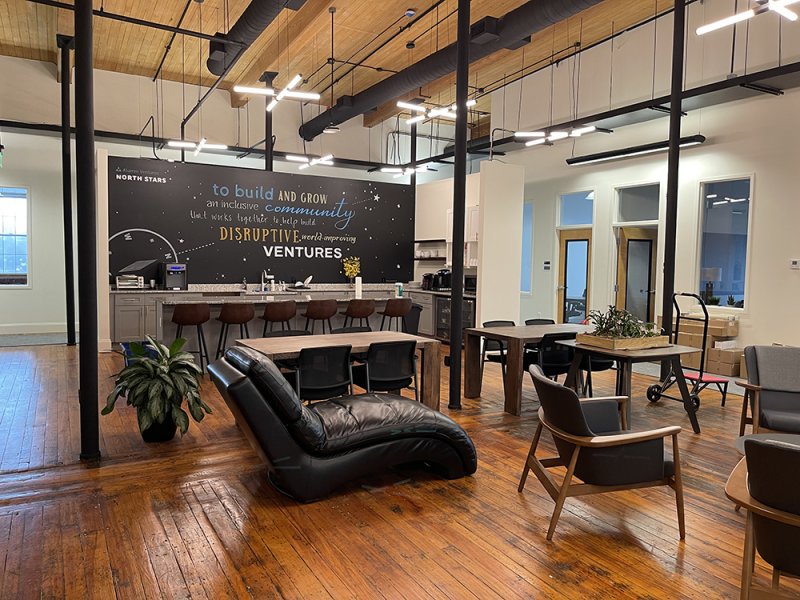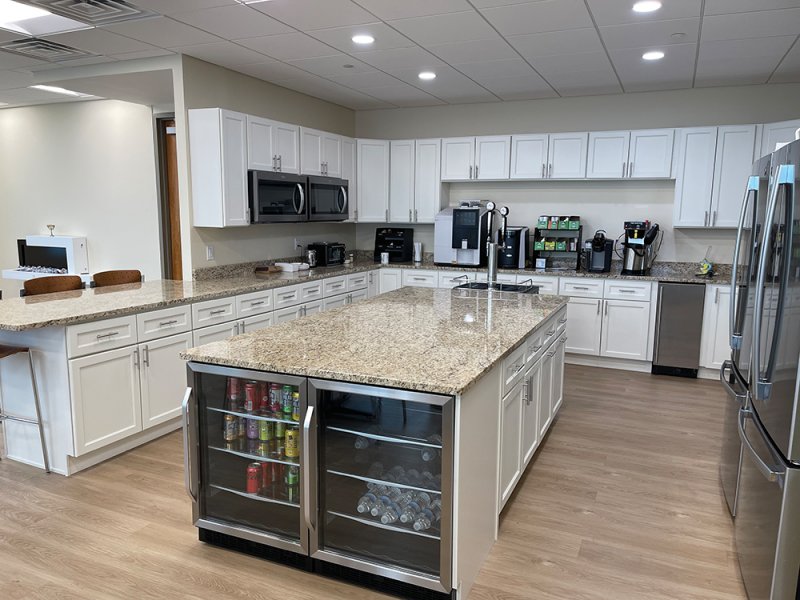
The Alumni Ventures office in Manchester, located inside a Brady Sullivan-owned building. Courtesy of Brady Sullivan.
A surplus of office space in NH means landlords will go a long way to hold on to good tenants. That surplus, combined with so many people working remotely, means tenants can negotiate from a position of strength.
“In general, office space is in abundance in New Hampshire,” says Chris Pascucci, managing director at SVN The Masiello Group in Bedford. “Whoever is negotiating for office space has the upper hand.”
Mike Reed, president of Stebbins Commercial Properties in Manchester, agrees it’s a tenant’s market. That means lessees they can ask for more in terms of fit up, preferred rental rates or abated rent on the front end of the lease that will graduate over time to market rate. They might even get a few months of free rent or additional parking, he says.
So, whether a company decides to downsize or expand, Pascucci says they should always start with their current landlord who will try to accommodate a good tenant. “A landlord would rather have someone take just the space they need and can afford rather than stretch and default,” says Pascucci. “When a lease comes up for renewal, that’s the time to go to the landlord, who can perhaps put up a demising wall and allow you to go from say 5,000 to 3,000 square feet. Or they [may] move you elsewhere.”
Reed says breaking up a space or setting up a sublease can relieve financial pressure. “When COVID first hit, a lot of people turned in the keys and walked away, and the pandemic hit the office market the hardest,” he says. “I was getting calls from clients saying, ‘What do I do? These offices are emptying out.’ I said do everything you can to work with them. If they leave, it will be a long time before you backfill.”
Arthur Sullivan, principal partner of Brady Sullivan Properties in Manchester, says he has the advantage of being able to offer a current tenant the right space at the right time. “We tend to have large buildings, like the three towers in Manchester,” says Sullivan. “This allows us plenty of opportunity to downsize and upsize for tenants.”
Rightsizing and Collaboration
James Tobin, director of commercial leasing at Brady Sullivan Properties, says they are even seeing some tenants go bigger.
“People are thinking businesses will get rid of office space or downsize, and what we are seeing is people actually having to grow their footprint. There has been some rightsizing and reducing of square footage for a hybrid model, but the overwhelming majority of people we work with really want the office environment and want to have that camaraderie that you don’t get on Zoom.”
Tobin says the market is close to equilibrium and does not favor either side. “Landlords are not saying ‘You’ll pay this no matter what;’ nor are tenants saying, ‘We will only pay x.’ What we focus on is putting deals together collaboratively. From the length of the term, size of the space, ability to grow or contract or move within the portfolio…we sprinkle in what’s most important to the tenant and to us.”
With so much to choose from, Joe Friedman, owner of Skyline Realty in Durham, says it is important to consider how a business will use the space, not just now, but in the future. Post-pandemic, there are many unanswered questions.
“We may see a full return to the office, but I don’t think anyone is really predicting that. We are seeing a lot more hybrid where some industries are back in the office and some allowing more flexibility,” Friedman says. “You may see more space per person for social distancing but fewer people. How that translates to square footage is still under review.”
Tobin and Sullivan say people are looking for large kitchen spaces and gathering areas, and more glass and open space, including more conference rooms, huddle rooms, and breakout areas.

Kitchen space at Nixon Peabody’s office in Manchester. Courtesy of Brady Sullivan.
“Pre-COVID, things were trending toward a more collaborative work area with benching and densely packed workstation configurations,” says Tobin. “Companies would often maximize the headcount in a certain part of the office. That has done a complete 180. Folks are now much more interested in having private offices and workstations with walls 5 to 6 feet high so that you are not in a quadrant of people sitting a foot from each other.”
Challenges
While it may be a tenant’s market for price, size and location, another important component of a lease, the fit up, is suffering from the high cost of construction materials, supply chain issues and the labor shortage. Despite being in the driver’s seat, firms may have to settle for fewer alterations or be prepared to wait.
If a company is looking to move to a new space, timing is critical because lead times are longer both in delivery of supplies and materials and getting things built, says Freidman. “That is something to factor in. Don’t wait until the last minute. Plan on it taking more time than you expect,” he says. “Almost all tenants want to make changes to the space. If you plan to, which is likely, build in more time and expect construction costs to be higher.”
The labor shortage is a nightmare, says Pascucci, and if a landlord cannot produce a space that meets a tenant’s needs, the renter may look elsewhere. He says firms, like Brady Sullivan that have an in-house work crew, have an edge.
“That is what’s different from two years ago. You’d call any contractor and tell them what you need, you take the bids and get it done,” says Pascucci. “Nowadays that doesn’t happen; contractors are backed up for months. Some deals will die over the inability to get the fit up needed. That is a pinch point right now.”
Sullivan says his firm benefits from economies of scale with vendors they have worked with for many years and are able to meet their commitments. Brady Sullivan can design tenants spaces through its architectural department, manage its own construction and handle leasing in-house, says Sullivan. “Right down to management of the building, we are a one-stop shop.”
Tobin says Brady Sullivan has 220 employees and was among the first to return to the office. “We are a large landlord and wanted to [demonstrate how to] safely return to the office. We offered virtual tours as [our tenants] were trying to figure it all out. Over the course of this year the vehicle counts have grown exponentially in our parking lots, and it is good to be interacting with tenants and prospective tenants on a daily basis,” he says.
Industrial is Always in Demand
The industrial market has been busy throughout the pandemic in part because of its design, says Reed. “The open-concept, high ceilings and frequent opening and closing of doors, particularly in warehousing and light manufacturing, hasn’t led to the same concerns as office where there still seems to be some hesitancy about repopulating enclosed spaces where proximity between desks is closer,” he says.
Friedman says industrial is a tight market, with high demand that continues to increase. “The users seem to need more and more for last-mile warehouse, distribution, e-commerce, the on-shoring of manufacturing, and it is all coming together at the same time, so prices are very high, construction costs are up,” Friedman says. “Everyone has the same question, ‘How do I get enough space?’”
As with office space, Pascucci recommends checking with your current landlord when shopping for more industrial space.
“The landlord will try to accommodate in the same building and may even offer space that is not contiguous where a company might have 8,000 square feet in their current location and lease another 2,000 for warehouse or storage on another floor or part of the same building.”
Despite the uncertainties in the commercial market, Pascucci says he has a positive outlook. “People said retail was dead but it is not; it is being backfilled by other users. When COVID hit, people said it was the end for restaurants, but they found ways to adapt. Offices are not closing; they are just reconfiguring the way they work. So, I am very bullish on real estate in New Hampshire,” he says.
